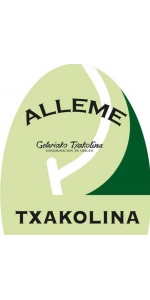Hondarrabi Zuri

Hondarrabi Zuri is a white grape variety grown only in Spain, and more specifically, the Basque region. The Atlantic Ocean has a tempering effect on the area which causes the citrus notes in the Hondarrabi Zuri grape to be lively and slightly herbal. Wines produced with Hondarrabi Zuri are meant to be consumed young and fresh, and are very easy to drink. In order to maintain the fresh quality, Hondarrabi Zuri wines have been known to be bottled with a touch of carbon dioxide. Hondarrabi Zuri is the most planted variety in the Basque region and is responsible for the base juice in the area’s Txakoli wines. The Txakoli de Getaria is the principal sub-region of Basque’s white wine production. Hondarrabi Zuri is also found in blends with the lesser varieties of the Basque region, including folle blanc, Chardonnay, Pinot Blanc, Sauvignon Blanc, and Riesling. Hondarrabi Zuri also has a corresponding red grape variety known as Hondarrabi Beltza. Hondarrabi Zuri grape bunches are tiny and dense with golden colored berries that are petite and round. The wine Hondarrabi produces is pale yellow in color with notes of ripe fruit, citrus, flowers, and herbs on the nose.
Alleme Getariako Txakolina is 100% Hondarribi Zuri
A very fruity, persistent and clean Txakoli. It reminds the white exotic fruits, such as lichy. It has a straw yellow color, without the slightest tone of rust and a faint natural gas pearl crown, due to the grape juice fermentation. In the mouth, it is greasy and unctuous, with a good balance of structure and acidity. In order to get such a Txakoli, we have combined the most traditional and the most innovative production methods to create it. Thanks to the batonnage (stirring of the lees), we have attained the characteristic unctuosity of this Txakoli.
After harvesting and pressing, the must is left to ferment in stainless steel tanks. Traditionally, and until recently, this was done in oak or chestnut barrels, called kupels, in Basque. Fermentation lasts 20–25 days and then the txacolí is left to lie on its lees. The CO2 prevents oxidation and dissolves the sediments and gives the wine its sparkling characteristic. The wines is not racked so it does not lose its sparkle and is clarified by natural sedimentation by gravity in the tank or barrel. Traditionally, the wine is tasted on the feast of San Antonio on 17 January, which is known as Txacolí Day (Txacoli Eguna, in Basque).
- back
Selected Options
Grape Types
Categories
Pricing
Countries
Regions
Grape Types
Wineries
Organic/Free Shipping
Paul Hobbs Chardonnay Russian River Valley is made from 100 percent Chardonnay.
Crafted with precision from six pedigreed sites comes a wine that beams with pale straw hue. The newest vintage brings wonderful aromatic intensity: candied lemon peel, white florals followed by crisp green apple. A creamy and viscous texture on the palate is buoyed by white nectarine and dried apricot that’s balanced with a vibrant acidity, bringing focus to the wine’s finish that lingers with hints of flinty mineral notes.
Review:
Filippino Elio Barbaresco San Cristoforo Riserva
Made from 100% manual harvest Nebbiolo, the wine comes from the hillsides of San Cristoforo hill in Neive enjoying a south-southwest exposure. The fruity bouquet offers subtle notes of violet and raspberries, combining with spicy hints of cinnamon, cocoa and leather. Full, enchanting and elegant taste, intense with a good body.
The best grapes are delicately pressed and the stalks are removed. The must ferments in stainless steel vats at a controlled temperature of 26°C with a maceration of 20 to 25 days. After racking, the new wine is put into 25 e 30 H Slavonian oak casks for long months. Next, it is bottled and left to age for at least an additional 24 months.





